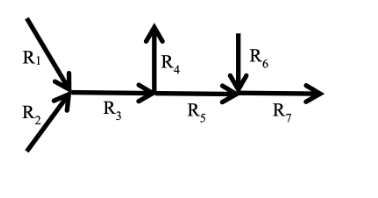A system of seven river segments is shown in the schematic diagram. The $\mathrm{R}_{\mathrm{i}}$ 's, $\mathrm{Q}_{\mathrm{i}}$ 's, and $\mathrm{C}_{\mathrm{i}}$ 's $(\mathrm{i}=1$ to 7) are the river segments, their corresponding flow rates, and concentrations of a conservative pollutant, respectively. Assume complete mixing at the intersections, no additional water loss or gain in the system, and steady state condition. Given: $\mathrm{Q}_1=5 \mathrm{~m}^3 / \mathrm{s} ; \mathrm{Q}_2=15 \mathrm{~m}^3 / \mathrm{s} ; \mathrm{Q}_4=3 \mathrm{~m}^3 / \mathrm{s} ; \mathrm{Q}_6=8 \mathrm{~m}^3 / \mathrm{s} ;$ $\mathrm{C}_1=8 \mathrm{~kg} / \mathrm{m}^3 ; \mathrm{C}_2=12 \mathrm{~kg} / \mathrm{m}^3 ; \mathrm{C}_6=10 \mathrm{~kg} / \mathrm{m}^3$. What is the steady state concentration (in $\mathrm{kg} / \mathrm{m}^3$, rounded off to two decimal place) of the pollutant in the river segment $7?$ ___________
